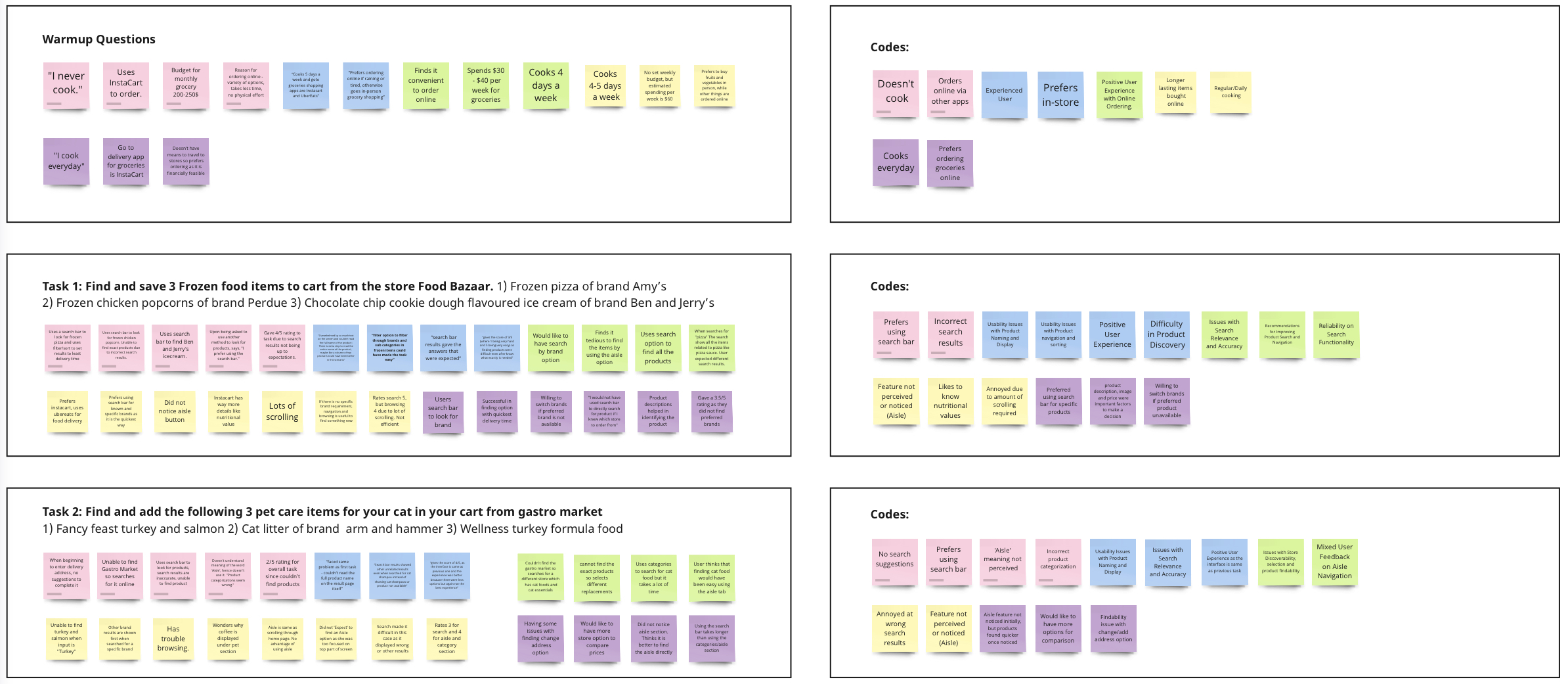Project Goal
To evaluate the usability of the grocery section within the Uber Eats app by employing various UX research methods to gather data and provide recommendations based on the findings.
Overview
Role: UX Researcher (Team of 5)
Duration: 4 weeks (April 2023)
Tools: UserTesting.com, Miro, Google Docs
Deliverables
-
Usability interview notes
-
Research plan document
-
Analysis & suggestions report
Research Methods
-
Moderated usability interviews
-
Think aloud testing
-
Heuristic analysis
-
Thematic analysis
My Responsibilities
-
Conducting interviews
-
Note-taking
-
Qualitative data analysis
-
Presenting findings & suggestions
Process
We chose moderated usability interviews with a think-aloud protocol to engage directly with users, obtain immediate feedback, and gain in-depth insights.
Moderated Usability Interviews
We recruited 5 participants: 3 experienced Uber Eats users and 2 frequent users of competing grocery delivery apps. This mix provided a thorough understanding of pain points for current Uber Eats users and allowed us to compare the app's usability with competing services.
Our discussion guide had a structured format, beginning with warm-up questions to understand participants' grocery shopping and cooking routines. We then assigned tasks simulating various features of the grocery delivery section, followed by follow-up questions to uncover contextual information and unexpected usability challenges. Finally, we collected post-task feedback to evaluate the overall user experience of the application.
Thematic Analysis
To analyze the interview data, we used thematic analysis. Each team member individually made notes for their conducted interviews, and then we employed a bottom-up approach: identifying common notes, creating codes, and grouping these codes into common themes.
Examples of how codes were formed from interview notes (Different colors were used to differentiate notes of each member)
Examples of how themes were formed by grouping codes
By applying this process to all tasks and post-task questions, we identified 9 themes.
User issues & suggestions
We identified usability issues within the themes and prioritized them, focusing on 2 key areas.
Theme 1: Product Naming & Description
A. Problem
Products with long names often hid the quantity information, making it difficult for users to quickly identify the quantity and leading to a less efficient shopping experience.
B. Problem
Uber Eats grocery section's product descriptions were less detailed than competitors' and often lacked essential nutritional information, limiting users' ability to make informed purchase decisions.
A. Recommendation
Display the quantity information prominently next to the product price for easier scanning and comparison.
B. Recommendation
Enrich product descriptions with detailed information and key nutritional values to help users make better choices and match competitor standards.


Theme 2: Search & Navigation
A. Problem
Participants were frustrated by the excessive horizontal and vertical scrolling required to browse the grocery section, which increased cognitive load and hindered quick product discovery.
A. Recommendation
Implement a listed view with drop-down menus to reduce horizontal scrolling. Streamlining navigation helps users find categories more efficiently and minimize frustration.
B. Problem
Users often overlooked the "Aisle" option in the bottom navigation bar, missing a convenient way to browse specific categories, which hindered their search and discovery process.
B. Recommendation
Enhance the visibility and prominence of the "Aisle" option by directly presenting the aisle view when a store is opened, encouraging efficient category-based browsing.
Additional Recommendations
Implement a brand filter
This feature would allow users to easily view products from their preferred brands, creating a more tailored shopping experience.
Add a cuisine based search
Enabling users to search groceries by cuisine preferences would provide relevant ingredient suggestions and inspire new recipes.




